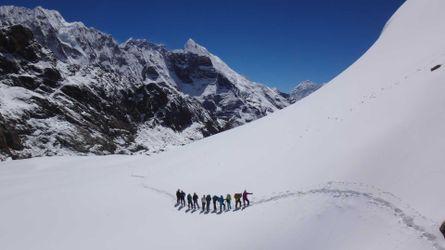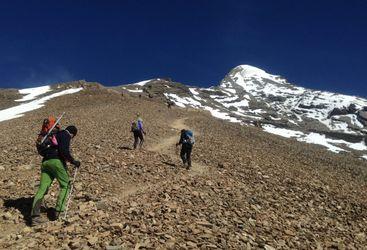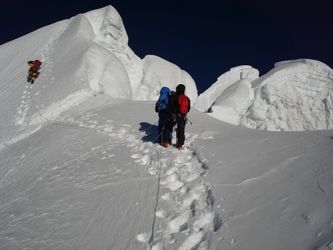Climbing Pisang peak





Pisang Peak, nestled in the Annapurna region of Nepal, stands at an impressive 6,091 meters. Known for its relatively accessible climbing route, it offers an enticing challenge to those who've already cut their teeth on other peaks. The approach is typically made via the village of Pisang, which provides a scenic backdrop for acclimatization. The climb itself presents a blend of rock and ice, demanding both technical skill and adaptability. Ascending Pisang Peak is not just about reaching the summit; it's about navigating its unique terrain and variable conditions with precision and care.
For those considering the climb, expect a route that alternates between moderate slopes and steeper sections requiring fixed ropes. The ascent is often approached from the southwest ridge, where climbers find the challenge of mixed climbing rewarding. Weather conditions can be unpredictable, with winds and sudden snowfalls adding to the complexity. The peak demands respect for its potential hazards, such as crevasses and avalanche-prone areas. Despite these challenges, the view from the summit rewards climbers with panoramic vistas of the Annapurna and Manaslu ranges, a sight that is hard to rival.
It's worth noting that Pisang Peak, while categorized as a trekking peak, should not be underestimated. Climbers need a good understanding of alpine techniques and strong physical conditioning. The mountain's popularity means it's well-frequented, but it also offers solitude and a sense of wilderness that's becoming rare in the more commercialized climbing spots. For those ready to take on its challenges, a total of 53 guides are available to support your expedition, though each climber must be prepared to rely on their skill and judgment when tackling this formidable peak.
Table of contents
Route
- 5,331 m gain over 17 days
- Starting and ending in Besishahar
- approach: drive, walk in
Walk in
- +3,570 m over a 110 km approach
- 5 - 7 days in
- 2 - 3 days out
Climb
- +1,400 m over 2 days.
- 1 high camp. Most climbers do not use high camps for this climb.
Difficulty
- PD: Not very hard (alpine grade 2)
- AD: Fairly hard (alpine grade 3)
When to go
- April and May
- October
Permits
- 3 permits are needed
- costing around $152 total
Guide mandatory?
- no
These are pictures taken while climbing Pisang peak. They're shown here to give you an idea of what the route is like. You're welcome to share your own pictures of climbing Pisang peak, to help the community of climbers. Picture here are either uploaded by members (their own, or creative commons pictures), or guides.
Guide links
Pisang peak History
Climbing history of Pisang peak
Pisang Peak, nestled in the Annapurna region of Nepal, has a history intertwined with the broader exploration of the Himalayas. The early summit attempts on Pisang Peak are not as well-documented as some of its more famous neighbors. However, it gained prominence with the rise of trekking and mountaineering in the region during the latter half of the 20th century.
The region surrounding Pisang Peak is home to the Gurung and Manangi people, whose rich cultural heritage adds a unique dimension to the area. The Gurungs are known for their traditional dances and vibrant culture, while the Manangis have a long history of trade with Tibet, which has influenced their customs and way of life.
 Pisang Peak Base Camp
Pisang Peak Base Camp
 High Camp
High Camp
 Pisang Peak Summit
Pisang Peak Summit
Pisang peak weather
How is the weather on Pisang peak, and when is the best time to go.
The best time to climb Pisang peak is during the autumn months of September to November, when the weather is generally dry and stable. The spring months of March to May are also a good time to climb, with warmer temperatures but more chance of precipitation.
The best time to climb Pisang peak is in these months:
- Apr
- May
- Oct
Pisang peak Gear Packing List
What To Take to climb Pisang peak
- Clothing:
- Base Layers
- Insulating Layers
- Shell Jacket and Pants
- Down Jacket
- Warm Hat
- Gloves and Liners
- Gaiters
- Hiking Boots
- Socks
- Climbing Gear:
- Mountaineering Boots
- Crampons
- Ice Axe
- Climbing Harness
- Carabiners and Quickdraws
- Climbing Helmet
- Rope (if not hiring a guide)
- Backpack and Luggage:
- Backpack
- Daypack
- Duffel Bag
- Stuff Sacks
- Sleeping:
- Sleeping Bag (rated to at least -20C)
- Sleeping Pad
- Pillow (optional)
- Camping:
- Tent
- Cooking Stove and Fuel
- Cooking Pot and Utensils
- Water Treatment System or Tablets
- Lighter or Matches
- Headlamp and Extra Batteries
- Sunscreen and Lip Balm
- Personal First Aid Kit
- Other Items:
- Trekking Poles
- Sunglasses
- Camera and Extra Batteries
- Power Bank and Charging Cables
- Travel Documents and Money
- Map and Compass/GPS
- Whistle and Emergency Blanket
- Toiletries
Pisang peak Services
Gear rental, porters, guides, transport, internet, accommodation
Accommodation
Tea houses or guest houses are available in the villages along the trekking route. Camping is also an option.Food
Food is available in the tea houses and guest houses, with a variety of options like dal bhat, noodles, soups, and snacks. Some places also offer international cuisine.Guides
Experienced guides are available for hire, and typically cost around $25-30 per day. They can help with navigation, provide local knowledge, and assist in case of emergency.Porters
Porters are available for hire, and typically cost around $15-20 per day. They can carry your gear and lighten your load while trekking.Medical facilities
Basic medical facilities like clinics and pharmacies are available in some villages along the route, but it's recommended to bring your own basic first aid kit.Gear rental
You can rent or buy gear in Kathmandu or in the nearby city of Pokhara. The gear you'll need includes a sleeping bag, down jacket, trekking poles, crampons, ice axe, harness, helmet, and more.Transport
To get to the start of the trek, you can take a bus or jeep from Kathmandu to Besisahar, then switch to a local jeep or bus to Chame. Private transportation can also be arranged.Internet / Phone
Connectivity is limited along the route, with intermittent phone signal and wifi available in some tea houses. It's recommended to bring a satellite phone or a personal wifi device for reliable communication.ATMs
There are no ATMs on the route, so it's recommended to bring enough cash for the entire trek.Shops
There are shops selling basic supplies like snacks, toiletries, and trekking gear in some of the villages along the route.Pisang peak permits
What permits are needed for climbing Pisang peak
1. Annapurna Conservation Area Permit (ACAP)
- $24 (~3,000 in the local currency)
- A permit to enter and trek through the Annapurna Conservation Area
- Can be obtained in Kathmandu or Pokhara, or at the entry checkpoint
2. Trekkers' Information Management System (TIMS)
- $8 (~1,000 in the local currency)
- A permit to provide information about trekkers and their routes for safety purposes
- Can be obtained in Kathmandu or Pokhara, or at the entry checkpoint
3. Pisang Peak Climbing Permit
- $120 (~15,000 in the local currency)
- A permit to climb Pisang Peak
- Can be obtained through a registered trekking agency in Kathmandu or Pokhara
Pisang peak access - getting there
How to get to Pisang peak
- Public Bus: This is the most common and budget-friendly option for getting to the start of the Pisang peak climb. Buses run regularly from Kathmandu to Besishahar, where you can catch a jeep to Chame, the starting point of the trek.
- Private Jeep: If you prefer a more comfortable and quicker ride, you can hire a private jeep from Kathmandu to Chame. This option is more expensive than taking the public bus.
- Domestic Flight: If you want to skip the long and bumpy road journey altogether, you can take a domestic flight from Kathmandu to Pokhara and then to Jomsom. From Jomsom, you can either trek to Chame or hire a jeep to take you there.
- Hired Car: Another option is to hire a car from Kathmandu to Besishahar and then take a jeep to Chame. This is a more expensive option, but you have more flexibility and can stop along the way if you want to.
Pisang peak questions
What to know about climbing Pisang peak
Common questions people have about this trek, if yours isn’t here - add it to get an answer.
These climbs are similar in length, difficulty, and elevation. Offering a similar level of challenge as the Pisang peak climb.


